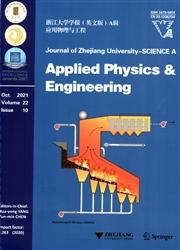Hele-Shaw槽内反向侵蚀管道动态过程的可视化
IF 3.9
3区 工程技术
Q1 ENGINEERING, MULTIDISCIPLINARY
引用次数: 0
摘要
随着地下空间的开发利用,在砂质含水层上的许多地下结构(如盾构隧道)中都出现了逆冲管。然而,由于管道的不可见性,侵蚀管道在成管过程中的几何形状及其随时间的空间演变尚不清楚。在这项研究中,我们开发了一种Hele-Shaw细胞来观察BEP的动态进展。利用成像处理技术,获得了典型的侵蚀过程(侵蚀过程可分为管道发展阶段和管道稳定阶段),定量表征了侵蚀管道的形成,并比较了不同水通量下自发形成的侵蚀模式(如侵蚀面积a和最大侵蚀半径R max)。最有趣的发现是,较厚的Hele-Shaw模型中的沙粒更容易被移除,这可能是由于较厚模型中的颗粒系统具有更多的自由度,从而降低了沙粒的稳定性。目的 粉土、粉(细)砂土承压含水层中的盾构隧道出现渗漏时,土颗粒会在渗流力作用下液化悬浮并随地下水涌入隧道,致使隧道外土层在高速水流侵蚀下快速流失,引起隧道受力模式改变,进而造成衬砌结构的连续破坏(损)甚至垮塌。特别地,当渗漏点位于隧道底部时,侵蚀过程类似于水利大坝中的向源侵蚀,即逆着水流方向在隧道结构底部产生侵蚀空腔,从而导致隧道底部因失去土层支撑而产生大范围沉降和错台。为研究盾构隧道结构底部某点处由径向水流(水流向漏点汇聚)引起的向源侵蚀过程及侵蚀区形态,本文采用物理学中的经典装置,即赫尔-肖氏薄板,开展一系列可视化的模型试验,研究了水流速度及试样厚度对侵蚀过程及侵蚀形态的影响,以加深对向源侵蚀机制的理解。 创新点 1. 研制了用于研究汇聚流下向源侵蚀过程的赫尔-肖氏薄板仪器;2.清晰地捕捉了向源侵蚀动态发展过程;3. 揭示水流速度及试样厚度对侵蚀过程及侵蚀形态的影响。 方法 1. 采用恒流速试验,模拟瞬间施加水流下的向源侵蚀过程;2. 通过数字图像处理技术,定量描述向源侵蚀动态发展过程;3. 通过调整板间距及入流速度,分析试样厚度及水流大小对侵蚀过程及形态的影响。 结论 1. 瞬时恒流下的向源侵蚀过程可分为侵蚀发展和侵蚀稳定两个阶段。2. 瞬时水流速度越大,侵蚀区的形状表现为分叉越多,最大侵蚀半径越大。3. 试样越厚,向源侵蚀越容易在赫尔-肖氏薄板中启动;同时侵蚀区面积越大,半径也越大。本文章由计算机程序翻译,如有差异,请以英文原文为准。
Visualizing the dynamic progression of backward erosion piping in a Hele-Shaw cell
With the utilization of underground space, backward erosion piping (BEP) has been observed in many underground structures (e.g., shield tunnels) founded on sandy aquifers. However, due to invisibility, the geometry of the eroded pipe and its spatial evolution with time during the piping process was still not clear. In this study, we developed a Hele-Shaw cell to visualize the dynamic progression of BEP. With imaging process technology, we obtained a typical process of BEP (the erosion process can be divided into a piping progression phase and a piping stabilization phase), quantitatively characterized the formation of erosion pipes, and compared the patterns of erosion (e.g., the erosion area A and the maximum erosion radius R max ) that spontaneously develop under different fluxes of water. The most interesting finding is that the sand grains in a thicker Hele-Shaw model are easier to dislodge, which is possibly due to the granular system in a thicker model having more degrees of freedom, reducing the stability of the sand grains. 目的 粉土、粉(细)砂土承压含水层中的盾构隧道出现渗漏时,土颗粒会在渗流力作用下液化悬浮并随地下水涌入隧道,致使隧道外土层在高速水流侵蚀下快速流失,引起隧道受力模式改变,进而造成衬砌结构的连续破坏(损)甚至垮塌。特别地,当渗漏点位于隧道底部时,侵蚀过程类似于水利大坝中的向源侵蚀,即逆着水流方向在隧道结构底部产生侵蚀空腔,从而导致隧道底部因失去土层支撑而产生大范围沉降和错台。为研究盾构隧道结构底部某点处由径向水流(水流向漏点汇聚)引起的向源侵蚀过程及侵蚀区形态,本文采用物理学中的经典装置,即赫尔-肖氏薄板,开展一系列可视化的模型试验,研究了水流速度及试样厚度对侵蚀过程及侵蚀形态的影响,以加深对向源侵蚀机制的理解。 创新点 1. 研制了用于研究汇聚流下向源侵蚀过程的赫尔-肖氏薄板仪器;2.清晰地捕捉了向源侵蚀动态发展过程;3. 揭示水流速度及试样厚度对侵蚀过程及侵蚀形态的影响。 方法 1. 采用恒流速试验,模拟瞬间施加水流下的向源侵蚀过程;2. 通过数字图像处理技术,定量描述向源侵蚀动态发展过程;3. 通过调整板间距及入流速度,分析试样厚度及水流大小对侵蚀过程及形态的影响。 结论 1. 瞬时恒流下的向源侵蚀过程可分为侵蚀发展和侵蚀稳定两个阶段。2. 瞬时水流速度越大,侵蚀区的形状表现为分叉越多,最大侵蚀半径越大。3. 试样越厚,向源侵蚀越容易在赫尔-肖氏薄板中启动;同时侵蚀区面积越大,半径也越大。
求助全文
通过发布文献求助,成功后即可免费获取论文全文。
去求助
来源期刊

Journal of Zhejiang University-SCIENCE A
工程技术-工程:综合
CiteScore
5.60
自引率
12.50%
发文量
2964
审稿时长
2.9 months
期刊介绍:
Journal of Zhejiang University SCIENCE A covers research in Applied Physics, Mechanical and Civil Engineering, Environmental Science and Energy, Materials Science and Chemical Engineering, etc.
 求助内容:
求助内容: 应助结果提醒方式:
应助结果提醒方式:


